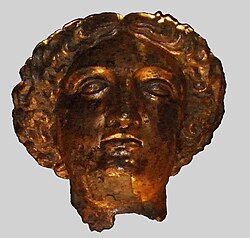Interpretatio graeca
Interpretatio graeca (Latin: "interpretation by means of Greek [models]") is how the religious concepts and practices, deities, and myths of Ancient Greece were used to interpret or attempt to understand the mythology and religion of other cultures. The term interpretatio romana (first coined by the Roman historian Tacitus in his book Germania),[1] refers to the process as it was used by the Romans. Results of this process included using the names of deities as epithets for others, and identifying them in accordance with their various roles and functions.
Interpretatio Graeca Media
Gilt bronze head from the cult statue of Sulis Minerva from the Temple at Bath
Syncretized figure from the Eastern provinces, perhaps a Genius (1st century BC – 1st century AD)
Worshipper before Zeus–Serapis–Ohrmazd (Bactria, 3rd century AD)
Votive relief to Isis-Demeter from Dion, Hellenistic period.





